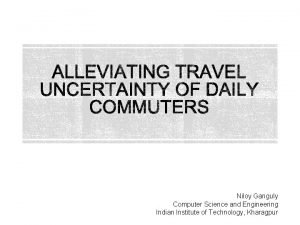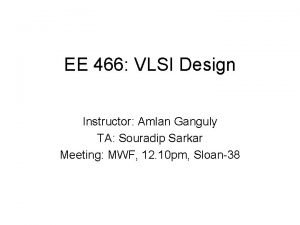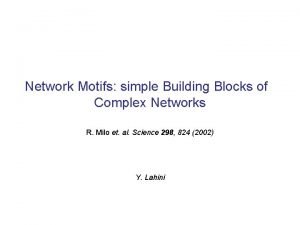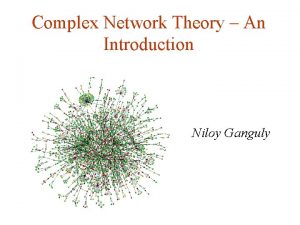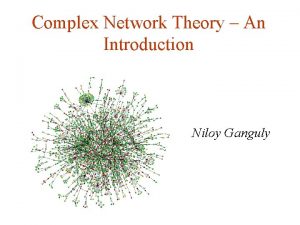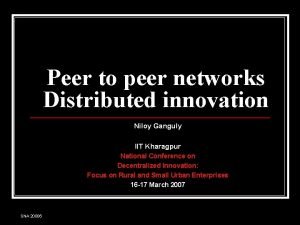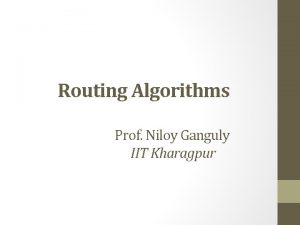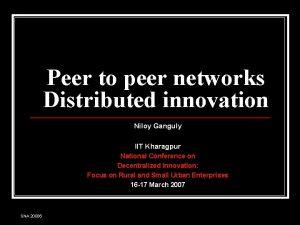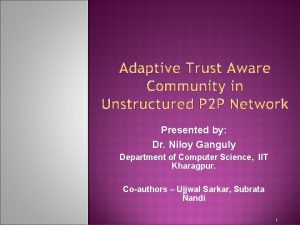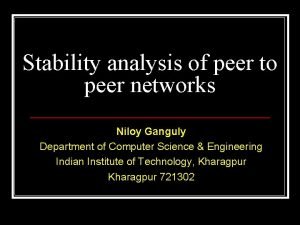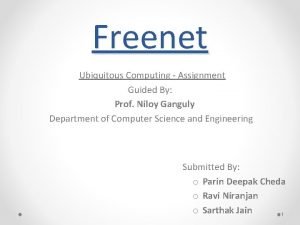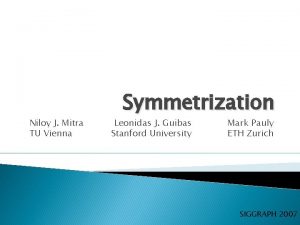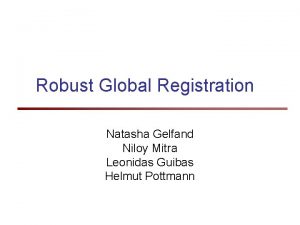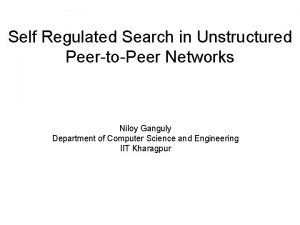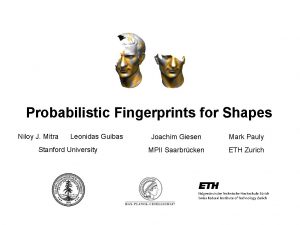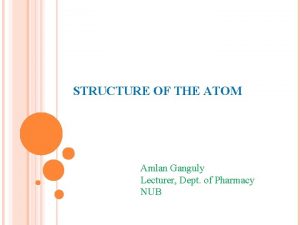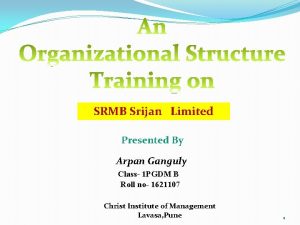Research Scopes in Complex Network Niloy Ganguly Complex
































- Slides: 32

Research Scopes in Complex Network Niloy Ganguly

Complex System l Non-trivial properties and patterns emerging from the interaction of a large number of simple entities l Self-organization: The process through which these patterns evolve without any external intervention or central control l Emergent Property or Emergent Behavior: The pattern that emerges due to self-organization

Complex System to Complex Network Statistical Mechanics Studied under Statistics Uses Modeled as Complex Systems Engineering Studied under Complex Network Uses Graph Theory

Complex Network Theory Handy toolbox for modeling Complex Systems l Marriage of Graph theory and Statistics l Complex because: l l Non-trivial topology l Difficult to specify completely l Usually large (in terms of nodes and edges) l Provides insight into the nature and evolution of the system being modeled

Business ties in US biotechindustry Nodes: companies: investment pharma research labs public biotechnology Links: financial R&D collaborations http: //ecclectic. ss. uci. edu/~drwhite/Movie

Business ties in US biotechindustry Nodes: companies: investment pharma research labs public biotechnology Links: financial R&D collaborations http: //ecclectic. ss. uci. edu/~drwhite/Movie

Structure of an organization Red, blue, or green: departments Yellow: consultants Grey: external experts www. orgnet. com

Internet

Friendship Network

Network Collaboration Network

Swedish sex-web Nodes: people (Females; Males) Links: sexual relationships 4781 Swedes; 18 -74; 59% response rate. Liljeros et al. Nature 2001

Road and Airlines Network -

Yeast protein-protein interaction network

9 -11 Terrorist Network

Genetic interaction network

What Questions can be asked l Does these networks display some symmetry? l Are these networks creation of intelligent objects or they have emerged? l How have these networks emerged? l What are the underlying simple rules leading to their complex formation?

What Questions can be asked l Can we predict some outcomes/ make statements about the health of the system represented by the network l Are these networks robust against failure l Does these networks help in information flow l How can we engineer (build) such network, (engineering complex systems).

Symmetry Poisson distribution Exponential Network Power Law distribution Scale free Network

The Small World Effect

The Small World Effect Even in very large social networks, the average distance between nodes is usually quite short. Milgram’s small world experiment: l Target individual in Boston l Initial senders in Omaha, Nebraska l Each sender was asked to forward a packet to a friend who was closer to the target l Friends asked to do the same Result: Average of ‘six degrees’ of separation. S. Milgram, The small world problem, Psych. Today, 2 (1967), pp. 60 -67.

9 -11 Terrorist (? ) Network How to conduct investigation

Swedish sex-web Nodes: people (Females; Males) Links: sexual relationships Internet • Robust against random failure • Vulnerable against attack 4781 Swedes; 18 -74; 59% response rate. Liljeros et al. Nature 2001

Some Interesting Research Areas l Language domain l l Social Network domain l l l Collaboration Networks Friendship network Biological Network domain l l l Consonants (Language) Networks Word network Language evolution Protein-protein interaction Gene regulatory network Technological networks domain l l l Delay Tolerant Network Internet Peer-to-Peer Network

Peer to Peer networks in the context of complex networks

Peer to Peer architecture Server Limitations of client server achitecture Scalability : Hard to achieve Client Poor fault tolerance : Single point of failure Client Administration : Highly required Peer to Peer networks Client Internet Client Node Internet Node l No centralized data source l File sharing and other applications like IP telephony, distributed storage, publish subscribe system etc All peers act as both clients and servers l Provide and consume data l Any node can initiate a connection l

Overlay networks Physical link Overlay edge q An overlay network is built on top of physical network q Nodes are connected by virtual or logical links Search and information flow follows overlay structure which makes underlying physical network unimportant q

Why overlay networks are Complex? l l This large number of computers are connected in overlay networks Dynamics in the network l l Network Evolution l l Peers in the p 2 p system leave network randomly without any central coordination Peers join the network by establishing a link with some existing node of the p 2 p network. Dynamics of overlay network makes the network complex in nature

Why overlay networks are Complex? l l The most important process in P 2 P networks is the search. In a search process there exists an inherent tradeoff between utilization of bandwidth and QOS i. e. latency. The increasing popularity and rapidly growing size of P 2 P networks in recent years gives rise to some non trivial issues such as overlay congestion, flash crowd, free-riding. Main challenge is to design fast, scalable as well as resource efficient search strategies.

Complex Network Research Group at IIT Kharagpur

Group Activities l 5 full time Research scholars l Several students are attached l Workshop organized at European Conference of Complex Systems, Dresden, Germany l Publishing Book volume named “Dynamics on and of Complex Network” l Collaboration with a number of national and international Institutions/Organizations l l Several research publications. Projects from government, private companies http: //cse-web. iitkgp. ernet. in/~cnerg/

External Collaborators l Technical University Dresden, Germany l Telenor, Norway l Complex System Institute Paris, France l Microsoft Research India, Bangalore l University of Duke, USA

Thank You
 Niloy ganguly
Niloy ganguly Niloy dutta uconn
Niloy dutta uconn Ashish ganguly imtech
Ashish ganguly imtech Indroneil ganguly
Indroneil ganguly Amlan ganguly
Amlan ganguly Types of counselling
Types of counselling 10 uncomfortable truths about the american revolution
10 uncomfortable truths about the american revolution Manfaat pemrograman terstruktur
Manfaat pemrograman terstruktur Free enterprise
Free enterprise What clash does the scopes trial represent?
What clash does the scopes trial represent? Educational psychology meaning nature and scope
Educational psychology meaning nature and scope What are the scopes of communication
What are the scopes of communication Scopes monkey trial
Scopes monkey trial Scopes programming language
Scopes programming language Simple compound complex and compound-complex sentences quiz
Simple compound complex and compound-complex sentences quiz Droplet infection
Droplet infection Simple, compound and complex sentences quiz
Simple, compound and complex sentences quiz Freud complexes
Freud complexes What theories
What theories Uniquisitive
Uniquisitive Network motifs: simple building blocks of complex networks
Network motifs: simple building blocks of complex networks Virtual circuit and datagram networks
Virtual circuit and datagram networks Types of network topology
Types of network topology Features of peer to peer network and client server network
Features of peer to peer network and client server network Network systems design using network processors
Network systems design using network processors Network centric computing
Network centric computing Packet switched network vs circuit switched
Packet switched network vs circuit switched Cerebral palsy research network
Cerebral palsy research network Tarn trauma
Tarn trauma Health care systems research network
Health care systems research network Diabetic retinopathy clinical research network
Diabetic retinopathy clinical research network Global research business network
Global research business network African midwives research network
African midwives research network
